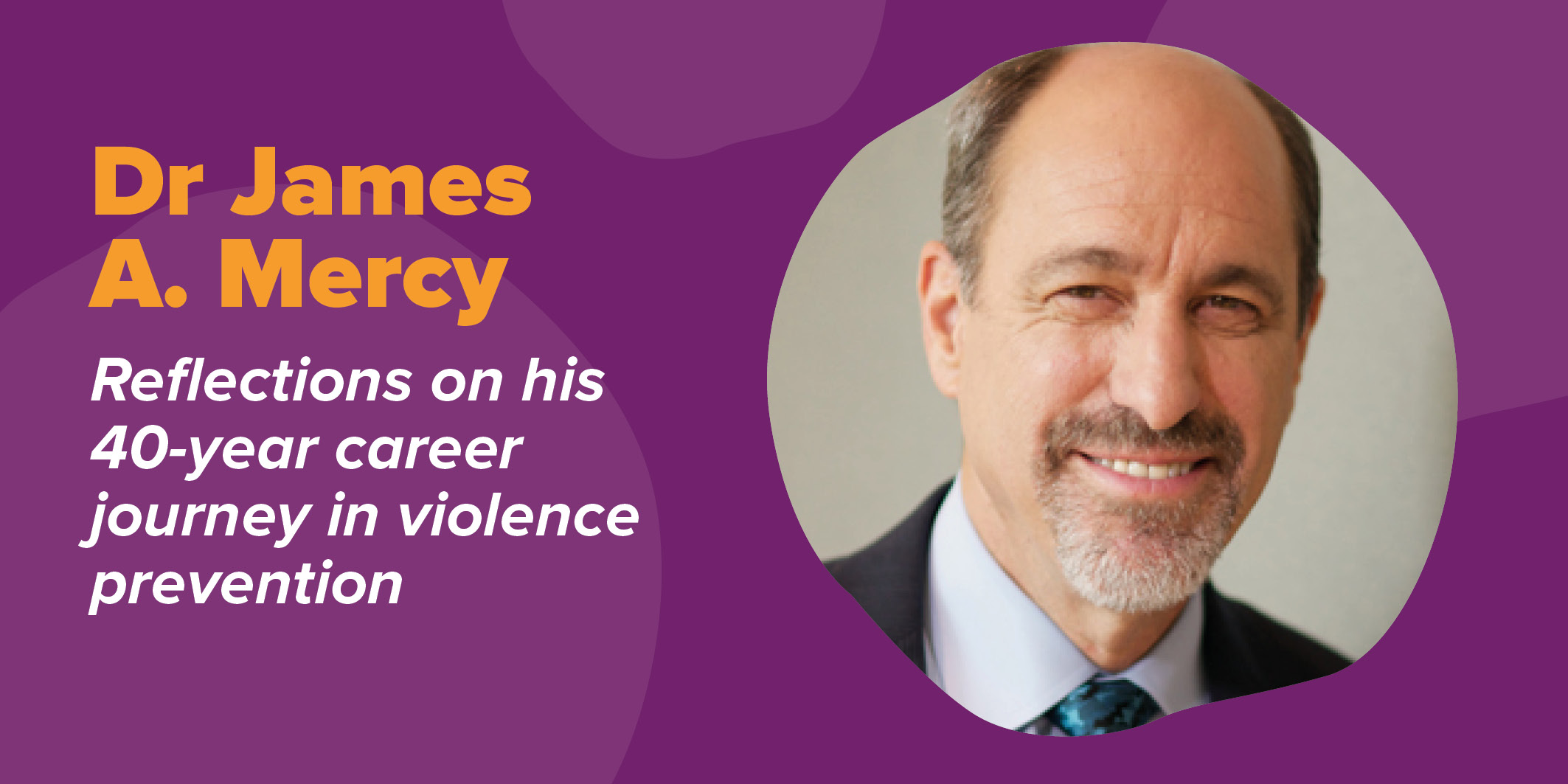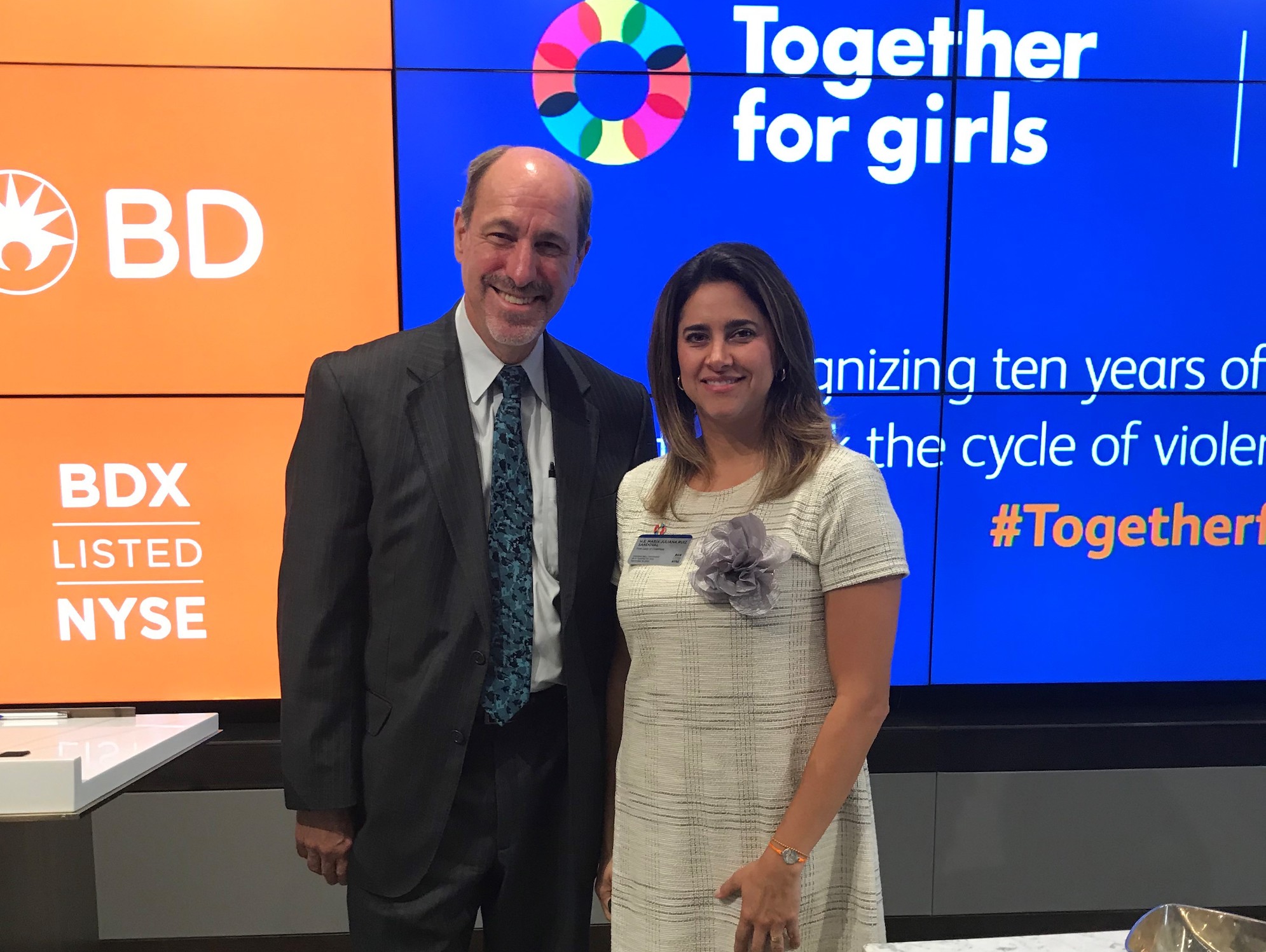
Dr. James A. Mercy has worked in violence prevention for over 40 years. He has been with Centers for Disease Control and Prevention (CDC) for the majority of his career, most recently as the Director of the Division of Violence Prevention (DVP) at its National Center for Injury Prevention and Control where he provided leadership to innovative research and science-based programs to prevent violence and reduce its consequences.
Through the course of his career, he has worked to develop the public health approach to violence prevention. As a researcher, Dr. Mercy has authored more than 250 publications that span across areas of violence, including child maltreatment and youth and intimate partner violence.
As he concludes his professional journey at CDC, he shares with End Violence important highlights, learnings and insight. He delves into the importance of evidence and data in informing policy, how the violence prevention landscape has evolved over the years, and the need for investing in science-driven knowledge and solutions.
Could you share with us the journey of your career - why and how did you join the violence prevention field and what have been some of your most memorable highlights?
My introduction to the field of violence prevention began over 40 years ago while I was doing my graduate work in Atlanta at Emory University in sociology. The research focus in my dissertation was on the relationship between police strength and crime in Chicago. I had over 120 years of data from various sources in the city and was analysing it to see if there were any associations between policing and crime.
I found essentially no relationship—the money spent on policing and the number of police did not affect the rate of property or violent crimes in Chicago. However, other variables such as poverty were strongly correlated with crime and violence. This raised the question in my mind: if having more police or providing greater funding for policing does not relate to the crime rate, what does? And how do we address this problem?
This piqued my interest in public health and how we could think about addressing violence and crime in a different way. I knew several people from CDC who were taking the same courses as I was in the sociology department at Emory. When I was coming to the end of my PhD, they encouraged me to apply to the Epidemic Intelligence Service (EIS) program, CDC’s globally recognised applied epidemiology training program. EIS officers are often referred to as the agency’s “disease detectives.” The idea of approaching violence as a public health problem was new, and CDC was just starting to focus resources on it. I was accepted to the program and was assigned to focus on violence.
I have been working on violence prevention in various roles ever since. When I started my career, the words “violence” and “prevention” were rarely used in the same sentence. I have been able to see the idea of violence prevention take hold as a public health issue. CDC was a key driver of this progress—not only in the U.S., but around the world.
When I started my career, the words “violence” and “prevention” were rarely used in the same sentence. I have been able to see the idea of violence prevention take hold as a public health issue.
When I began working at CDC, there were only three people at the agency focused on violence prevention. Now we have over 200 staff focused on a range of issues from child abuse and neglect to youth and community violence, to intimate partner and sexual violence, to violence involving firearms and more.
Key stages in the evolution of the field that I’ve observed include:
· The development of a public health framework for preventing violence. During the first decade of my career at CDC we focused on developing concepts and using data to convince people that violence was a public health problem. We demonstrated how the discipline and tools of public health could contribute to preventing violence at the population level.
· The investment in research to create an evidence-base for violence prevention. CDC supported and funded the first study on adverse childhood experiences. Up until that time we had been characterising violence as an injury problem. But that study, and the many related that followed, showed us that violence not only contributes to physical injuries, but is an important risk factor for mental health problems, reproductive health issues, infectious disease such as HIV, and chronic illness as well. This led to the realisation that preventing violence was strategic from a public health perspective. While research on what works needs to continue, we now have a substantial evidence-base for preventing many forms of violence.
· The shift to a focus on implementation. Following the robust body of evidence collected on risk and protective factors and ways to prevent violence, the field has now begun to focus on implementation. The challenge now is to build on the knowledge and good data on what works and figure out how to best implement, adapt, and scale it up.
· Contributions to violence prevention around the world. I am immensely proud of our international work on violence against children, especially in relation to the Violence Against Children and Youth Surveys (VACS) and the creation of INSPIRE (a compendium of the best available evidence for preventing violence against children). This work started in 2006 and had a tremendous influence on me and for the global field. We started this work in Eswatini (then Swaziland) to investigate media reports about the sexual abuse of girls by teachers. This led to a survey that demonstrated the scale of sexual abuse of girls as well as their exposure to physical and emotional violence. That work led to policy and programmatic changes that contributed to dramatic declines in physical, sexual, and emotional violence against girls in Eswatini over the last 15 years. This initial work led to VACS being conducted and INSPIRE being applied in over 25 countries around the world.
You have been leading innovative research and science-based programs to prevent violence at a large scale and played a critical role developing INSPIRE. Are there any particular solutions that you would highlight as most effective?
I am always reluctant to point to just one strategy. I believe we must take a comprehensive approach where potentially effective prevention strategies are selected based on the unique profile of violence against children that is apparent in specific countries. Selected strategies must also be adapted to social and cultural contexts of specific countries. Having said that, I believe that strengthening the economic security of families is fundamental to preventing violence against children in virtually every country.
CDC is the US’s leading science-based, data-driven, service organisation that protects the public’s health. Can you talk about how the data landscape has changed over the past decades and why this is important?
Twenty years ago there was very little to no data on violence against children in most countries around the world. UNICEF was collecting data through MICS (Multiple Indicator Cluster Surveys), but the violence content in these surveys was limited to data on parenting practices and corporal punishment. With the first VACS conducted in 2007 we began to help address this important gap. VACS has helped accelerate the availability of data on the magnitude and nature of violence against children and its connection to other health issues.
VACS came about when we were invited to Eswatini (then Swaziland) to do a study based on media reports of teachers sexually abusing girls in schools. Rather than focus specifically on teachers and schools we decided to investigate violence against girls more broadly. The data were striking—teachers were not the primary perpetrators driving sexual violence. Instead, most girls experienced sexual violence from boys and men they knew in their neighborhoods. Teachers only contributed around four percent of the burden of sexual abuse among girls. These data were critical in helping shape the direction and focus of prevention efforts. Had we focused on abuse by teachers in and around schools we would have missed the most important dimensions of the problem.
The VACS in Eswatini was enormously influential in changing the course of programming and policy. Before 2007, the country had very limited laws protecting girls and women from violence. The government used results of VACS to raise awareness of the problem of sexual violence against girls, pass the first Sexual Offences and Domestic Violence Act, and implement several important prevention as well as child-friendly response programs. The Sexual Offences and Domestic Violence Act, in particular, was groundbreaking in strengthening legal protections for victims and potential victims.
What the government and people of Eswatini achieved inspired other countries to undertake the VACS to collect this important data to inform action. Tanzania, the second country to do a VACS—used results to ban the use of physical punishment in schools and implemented policies for teacher codes of conduct and teacher training to eliminate physical violence in schools. The framework for the codes of conduct and guidelines were announced at the release of the final VACS report and implemented in all schools and classrooms nationally.
The collection of quality evidence and data to end violence against children around the world remains a critical barrier to progress. What needs to happen to change this?
One of the barriers to collecting data on violence against children is the perception that the costs are prohibitive and that such funds could be better used on response programs. Our experience with the VACS has made clear that investments in strong data almost always lead to investments in prevention policies and programs, whose benefits far outweigh the costs of data collection. Investing in data on the problem greatly assists countries in selecting appropriate prevention and response strategies. It may also strengthen the political will needed to address the problem. In addition, it provides a benchmark against which to measure progress. Ultimately, policymakers, scientists, and practitioners alike, can do a better job of emphasising the enormous benefits of collecting high-quality data.

Dr. James Mercy withMaría Juliana Ruiz, Former First Lady of Colombia
What are some of the challenges you have faced in the field? Any lessons learned you’d like to highlight?
The biggest lesson from my career would have to be the importance of building partnerships.
INSPIRE—a compendium of the best available evidence for preventing violence against children–came about because of partnership. The INSPIRE partnership included 10 organisations that provide global leadership on health, human rights, and related issues including: CDC, WHO, Together for Girls, UNICEF, USAID, PEPFAR, The World Bank, PAHO, UNODC, and End Violence. These organisations joined hands to provide leadership on preventing violence against children and release INSPIRE. The success of INSPIRE is a testament to the power of partnerships. Before INSPIRE, several organisations had technical guidance on the prevention of violence against children. For example, CDC had domestic guidance for the U.S., UNICEF had its own version of the best prevention strategies, and WHO another set. The overall approach across these documents was similar, but we were speaking from different platforms and to different stakeholders and audiences. By coming together, we were able to speak with one voice to say to the world that violence against children is a major public health and human rights issue that can be prevented.
The biggest lesson from my career would have to be the importance of building partnerships.
This is how INSPIRE was born—it was about partners speaking with one voice about what are the best practices and evidence-driven recommendations for preventing violence against children.
The content of INSPIRE was of course important, but the organisations coming and standing behind it was the major success and has accelerated a global push to end violence against children.